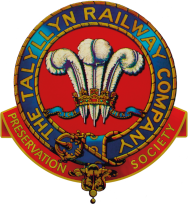On 21 February 2018 the Talyllyn Railway celebrated the centenary of its locomotive No.6 ‘Douglas’ in style, by revealing it in a brand new livery of RAF Traffic Blue to mark the 100th anniversary of both it and the RAF.
It was constructed at Andrew Barclay Sons and Co. in Kilmarnock as a 2ft gauge 0-4-0 tank locomotive originally for use at the Royal Naval Flying Corps airfield at Manston in Kent. A few weeks later, on 1 April 1918, the Royal Air Force was formed and the airfield became RAF Manston, and so the locomotive’s connection with the RAF began.
In 1921 it was transferred to RAF Calshot. This was the RAF’s sea plane base in the Solent in Hampshire. Here it worked transferring personnel and stores on a line along Calshot Spit. When the line closed in 1945 the locomotive was eventually sold to Abelson and Co. in Birmingham. It remained there until 1953 when it was donated to the newly preserved Talyllyn Railway.
The only condition of the donation was that the locomotive should be named after the then Managing Director of Abelsons. Thus it became Talyllyn Railway No.6 ‘Douglas’ and, after regauging to the Talyllyn’s 2ft 3in gauge, it was delivered to Tywyn in July 1954 where it has remained in regular service ever since.
With the centenary of the locomotive coming up and realising that 2018 also marked the centenary of the RAF, the Railway has worked with the local RAF Association to mount a joint celebration of both centenaries. This took place on Wednesday 21 February 2018. During the event the locomotive was officially adopted by the Association. In attendance was the Lord Lieutenant of Gwynedd, Mr Edmund Bailey and Lord Elis-Thomas AM, Minister for Culture, Tourism and Sport, who has had a long association with the Railway, also present were representatives of the RAF, the RAF Association and other local dignitaries.
At 11 am the locomotive steamed into Wharf station in its new livery to be greeted by the assembled crowd. Crewing the locomotive for the day were a current and a past member of the RAF, the latter being Chris Price formerly General Manager at the Talyllyn Railway. There were speeches and presentations to mark the event hosted by the current General Manager, Stuart Williams. This was followed by lunch after which No.6 hauled a special train for a short trip up the line for the assembled guests.
Commenting on the occasion the RAF’s Air Officer Wales, Air Commodore Adrian Williams said:
“As the RAF celebrates its centenary in 2018, it is a real privilege to be able to commemorate and celebrate the centenary of an original RAF steam engine from 1918, that is now part of the Talyllyn Railway. Whilst the aircraft of the RAF have always tended to grab the attention and the headlines, there is so much more to the RAF and our history. In this RAF centenary year, as we celebrate our creation as the world’s first independent Air Force, it is fantastic to work with the Talyllyn Railway and recognise the very special connection between this steam engine and the RAF, all the way back to our very first days as an Armed Service. In order to more fully recognise the unique importance of this steam engine in RAF history, the RAF also plans to carry out a further commemorative public event with the engine at Talyllyn Railway later this Summer.”
Ian Drummond, chairman of the Talyllyn Railway Preservation Society, commented:
“When considering plans for locomotive No.6’s centenary it was felt appropriate to mark its long association with the RAF. Therefore, the event on 21 February and the new livery celebrates that connection. We are delighted at the overwhelmingly positive response there has been, both during the event and on-line. The superb finish on the locomotive is a tribute to our paintshop team and thanks must also go to the local RAF Association for the help they have given us.”
A further celebration of the locomotive’s centenary will take place over the weekend of 1,2 and 3 June 2018. Called ‘Leave on the Line’ the event will have significant RAF involvement as well as reminders of life during the First and Second World Wars.








